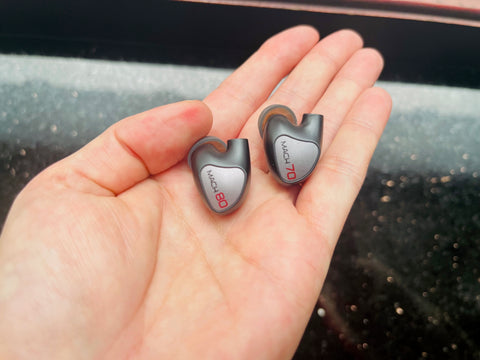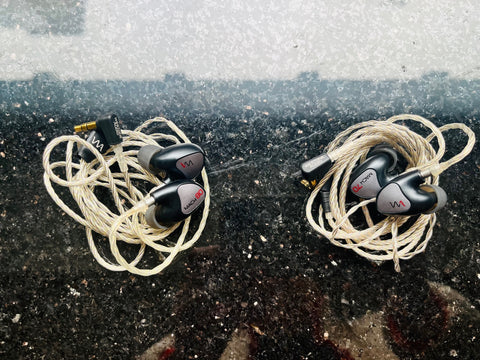Westone MACH 80 vs MACH 70 Review
by Gabby Bloch
(Updated )
Bookmark this article
Copy to clipboard
Email to a Friend

With only one driver separating the Westone MACH 80 and MACH 70, many are curious to know what the variations are between the two models, especially since these they only differ in price by $200. So, let’s take a look at these two models to see how they compare in terms of sound signature and performance.
Design
The MACH 70 employs 7 balanced armature drivers - 1 Bass, 2 Midrange, 4 Treble. In contrast, the MACH 80 has one extra driver in the low-end - 2 Bass, 2 Midrange, and 4 Highs.

At 42 Ohms, the MACH 70 is easier to drive than the MACH 80 (66 Ohms). This is not only because the 70’s impedance is lower, but it also has a higher sensitivity. So, you’ll get a more volume from the MACH 70, which can be comfortably driven from your phone without a DAC/Amp. The MACH 80, though not incredibly difficult to drive, could use a DAC/amp dongle to optimize power.
Both models employ Linum UltraBaX™ T2 Cable which is made from 224 strands of silver-plated copper. Like all of Westone’s new models, the 70 and 80 use a T2 connection, which many argue, is a more solid alternative to the sometimes temperamental 2-pin and MMCX connectors. Both models also have a 3.5mm unbalanced termination.

Sound Impressions
Soundstage
Both IEMs deliver incredible imaging, and in fact, there is very little discernible difference between the two models in this department. Both, the MACH 70 and MACH 80 not only offer plenty of height, but the sense of depth is amply perceivable. You’ll hear subtle degrees in placement behind and in front of the ear. And although the stereo field is not immensely wide, there is plenty of space between instruments. So, they both deliver a clean and thoroughly multidimensional soundscape that feels immersive and vividly colorful.
Low-End
While neither model presents a particularly heavy bass response, the MACH 70 delivers a punchier and deeper sounding low-end than the MACH 80. And the MACH 70 has a thicker low-end profile overall, giving this range more warmth. At the same time, string instruments perhaps sound more natural on the MACH 80, while also revealing more texture. In contrast, the M70 conveys a slightly smoother sound.
Mids
Though the frequency graphs might indicate otherwise, the MACH 70 displays a flatter sounding midrange than the MACH 80. While the MACH 70 has a move even distribution between the low and high-mids, the MACH 80 favors the upper half of the midrange. As a result, the MACH 70 offers a lusher and more full-bodied sound, while the MACH 80 sports a more dynamic and lively profile, where instruments like snares, guitars and vocals are protrude through the mix.
Highs
Very few differences in this range. The MACH 70 is perhaps a touch less extended, making for slightly smoother peaks in the very highest treble points. But to be honest, the difference is so small, that it’s often hard to even tell. Both IEMs do an equally fantastic job of revealing nuances in strings and vocals. However, the MACH 70 might display a bit more air and buoyancy, which becomes apparent mostly with respect to vocals. In contrast, the MACH 80 feels a just a touch heavier, more colored and less delicate. But again, the difference is less than stars, and these variations may not bother you unless you’re a huge stickler for airy and light treble.
Summary
In terms of skill, there’s very little difference between these two IEMs. But in comparison to the MACH 80, the MACH 70 has a puncher, deeper and warmer low-end, more even-handed midrange, and perhaps slightly more delicate and airy highs. The MACH 80 also has a more dynamic feel, while the MACH 70 is lusher and more full-bodied. In addition, the MACH 80 often seems to present a more natural acoustic instrument, especially in the lows. So, overall, when choosing between these two great performers, the decision ultimately comes down to taste rather than performance.
You can buy the Westone MACH 80 and Westone MACH 70 at Audio 46.
Specifications
|
|
MACH 80 |
MACH 70 |
|
Drivers |
8 Balanced Armatures - 2 Bass, 2 Midrange, 4 Treble |
7 Balanced Armatures - 1 Bass, 2 Midrange, 4 Treble |
|
Frequency Response |
5Hz - 22kHz |
5Hz - 22kHz |
|
Sensitivity |
104dB |
110dB |
|
Impedance |
66 Ohms |
42 Ohms |
Get the Latest Headphone News and Reviews in Your Inbox
Subscribe to our newsletter and get 10% off your first purchase!*
*some restrictions may apply


 FREE
FREE 


